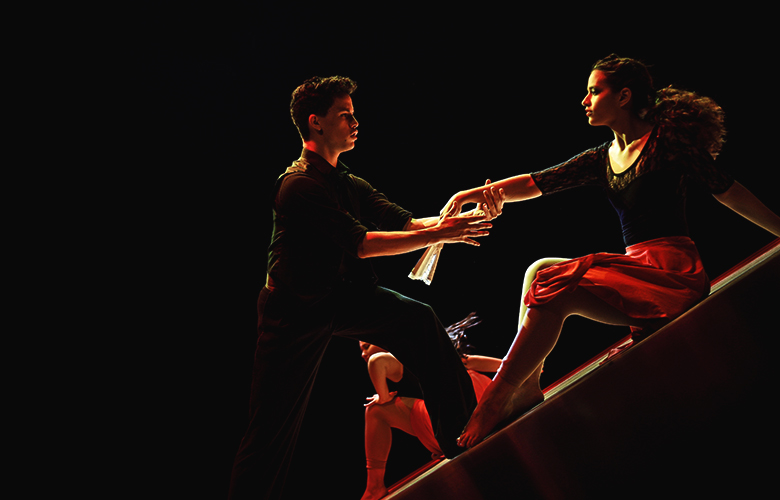
5, 6, 7, 8! Five, six, seven, eight… Cinq, six, sept, huit… Fünf, sechs, sieben, acht!
We’ve all heard or spoken those counts, regardless of one’s mother tongue, of whether or not we’re earning a living on stage. Essential to any choreographer, these four international words have been immortalized in A Chorus Line’s cast album’s opening track. The art of choreography however goes far beyond than those counts. In the same way that certain dance numbers have become some shows’ lasting image and brought recognition to their creators, some steps have marked the collective imagination and become as famous as certain lines or lyrics.
There is something in West Side Story’s Prologue’s snaps and in Sally Bowles’ hip rolls in Cabaret. This indescribable flair is also present in instrumental, dance-only numbers like Cats’ white cat solo. Such steps and sequences have stood the test of time and can still be seen on stage several decades after being created. Jerome Robbins, Bob Fosse, and Gillian Lynne who have choreographed previously cited productions were aware that a great choreographer knows how to make the best use of a cast’s energy, which ultimately allows artists to express themselves and connect with their audience in ways that no line nor show tune can. Their spirit and original inspiration have never left these shows, even if given a fresh take by new creative teams in countless revivals.
“A choreographer has to have a tremendous instinct for what is right, one that has hopefully been developed through experience in getting there. They must also have huge people’s skills to nurture those who are slow and might need more time to get it while being driven with a whip for others rehearsing in the very same room. It really is about getting this balance right. You have to inspire, you can’t just stand there and be brainy and intellectual.” said the late Gillian Lynne when asked to define her profession in the early 2000s.
The same sentiment also applies to directors who go all-in at times by both directing and doing choreography. Jerry Mitchell notably did so for Kinky Boots, On Your Feet! or Legally Blonde, while Casey Nicholaw has been at the reins of Aladdin, The Book of Mormon, and Mean Girls on Broadway. The latter one enjoys doing both as he feels they come from the same voice. If a love for story-telling through dance numbers is a must for any choreographer, the real challenge is in the ability to keep the story going without stopping it all to dance for dance’s sake alone according to the former dancer.
“There is this energy that makes you want to do better. It’s passion! Dance embodies me and traps me in the most amazing way! These dancers are looking with all their life in their eyes and it all goes into this moment, into the show.” said Sonya Tayeh to describe her work in the musical adaptation of Moulin Rouge! Such enthusiasm resonated among the cast and audience members since the 2018 production was highly praised for its choreography, earning Tayeh three awards for her work as of Spring 2020.
Then there are those numbers that are worth the admission’s price alone, those where sets, props, music, and dance unite as one to create an unforgettable moment. Thanks in huge parts to Tony-nominated choreographers Matthew Bourne and Stephen Mear, Mary Poppins’ epic chimney-sweeps’ tap dance set on a rooftop with chimneys and night lights moving mesmerizingly with and around dancers is of those that have gone down in history. The Lion King’s Circle of Life with its amalgam of puppets, jungle-looking props, moving sets, and dancers surrounding a rising sun is a masterpiece and the result of Julie Taymor and Garth Fegan’s collaboration, both Tony Award winners for directing and choreography.
The diversity of shows and art forms has also proven through time and stages that dancers are not the only ones to rely on and collaborate with choreographers. Many actually ventured away from theatres wings and orchestra pit, making skating rinks and gymnastic halls their creation labs. Ice skaters, gymnasts, and synchronized swimmers are all benefiting from artistic eyes and creative minds that can link tricks, highlight skills, and use their raw energy to deliver a more complete performance. All those Olympians transitioning to the stage passed their competitive years have underlined that choreographic help is also needed elsewhere!
The former dancer is without a doubt the company’s most prolific choreographer with collaborations that spread between the early 80s to the mid-2000s. By moving away from the skills and stunts, by integrating more movement and dance elements to circus acts when the contemporary circus or “Nouveau Cirque” movement started, the American choreographer was one of the first to re-think acts’ conception. Her approach has proven successful and inspired many others to specialized in acrobatic, aerial, and juggling choreography.
“I don’t like to call the show a machine, but I first had to acknowledge and understand the machine’s potential to put my creativity and the swimmers at the best of use.” said her former colleague Sylvie Fréchette during the creation of“O” in Las Vegas. The Olympic medalist had to choreograph nine routines for a team of swimmers who would at times appear like the show’s aquatic corps de ballet, backdrop, main attraction, or props movers. The emphasis would no longer be on the routine’s technical aspect, no marks would be attributed, and swimmers would also have to embrace characters as well as several of the show’s theatrical aspects.
Tossing a hat or stretching a leg on a 3 instead of a 6 can make a huge difference, rolling down instead of crouching can give a whole other interpretation to one’s delivery. Some refer to the way a chef assembles, preps, and mixes ingredients as a choreography, one where using salt instead of sugar on a 5 or waiting 10 instead of 15 minutes can definitely change the final result. Next time you hear “5, 6, 7, 8” try and look for what some choreographer might be creating on a stage, in a pool, or behind a counter!
A Circus Career: Staying Balanced and Inspired
Ulrike Storch: Let Me Educate You


Impassioned by performing arts, Martin Frenette started intensive dance training at a very young age before trading pliés and barres for ropes and somersaults at Montreal's National Circus School. He has spent a decade in Europe, performing in various productions. Circus Monti, Chamäleon Theater, Wintergarten Varieté, Cirque Bouffon, GOP Show Concepts, and the Friedrichsbau Varieté have allowed him to grow artistically and humanly. Martin has also invested time working as an artistic consultant, director, and choreographer for both circus and dance projects. He enjoys splitting his time between Europe, Canada, and the US, working on stage and creating for others. Writing has always been a big passion of his and he's thrilled to share his views on shows, the stage, and what's going on behind the scenes with other performing arts enthusiasts!
Read Full Profile© 2021 TheatreArtLife. All rights reserved.

Thank you so much for reading, but you have now reached your free article limit for this month.
Our contributors are currently writing more articles for you to enjoy.
To keep reading, all you have to do is become a subscriber and then you can read unlimited articles anytime.
Your investment will help us continue to ignite connections across the globe in live entertainment and build this community for industry professionals.